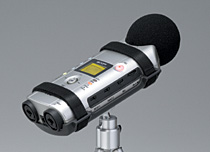|
Initial Thoughts Outside of Japan Zoom is virtually unknown as a company, but their entry into the hand-held digital recorder market is about to change all that. The Zoom H4 is one of the cheapest units on the market and yet it still includes features such as twin balanced XLR inputs, phantom power and multi-track recording functionality. The H4 is going to change the way people think about portable recording. I was living in Japan when I first saw the Zoom H4, in fact the first one I bought I sent to my brother in England as a birthday present; it was a couple of months later before I picked one up for myself. Initially I was concerned with its size because I already owned an Edirol R09 which was easily pocket sized and the H4 was much too big to carry in my pockets. Also initially when I used the H4 with its built in mics I found them far more susceptible to wind noise the the mics on the R09. Where the H4 really started to come into its own was when I used it for serious recording. The Zoom H4 has 2 modes of phantom power and so was perfect for using with my Sennheiser MKH60. It completely removed the need for a bulky inline phantom power unit I had been using. It also had balanced XLR inputs which neither the R09 or my old Sony portable DAT recorder had. The increase in quality was sudden and very obvious. After only a couple of recording sessions using the H4 with the MKH60 I realized I had entered a phase of my sound recording. Not only was the H4 a better record than I had previously used, it was also smaller and lighter and made being mobile much easier. The H4 comes packaged with quite a few useful accessories, the most useful for me was a mounting plate with a screw thread hole to attach the H4 to a camera tripod. Although I did find it interesting that they chose to match the thread on a camera tripod rather than a standard microphone stand size, I later came to appreciate this feature. For a start a camera tripod is much lighter and more compact than a microphone stand so was another plus for mobility. Also I adapted an old broken tripod I had and mounted the attachment head onto the side of my boom pole allowing me to mount the H4 directly onto the boom pole just beneath the microphone mount. This allowed my entire recording setup to be mounted on a single pole. This was so useful and convenient that I still use this exact system 3 years later. The unit itself can be used as a four track recorder, but only by recording up to two tracks initially and then a further two tracks at a later time. This is not a feature I have ever used. Many small digital units like both the R09 and H4 include a range of software features that I find somewhat pointless. Being able to add reverb and other effects to sounds on board seems to be pointless to me as there is almost endless software available that will serve this same purpose. I would rather a good basic recording unit that does its primary purpose well rather than a bunch of extra features that I suspect few people will use. The H4 uses SD memory cards for data storage, and depending on what recording rate you are using you can recording significant amounts of data on even a 1 gig card. Available recording formats are 44, 48 and 96 KHz wav file and mp3. I tend to use 48KHz most times unless I am recording sounds with extreme high frequency material such as breaking glass or something similar. The battery life on the H4 is quite good. I use rechargeable batteries and a four gig SD card at 48KHz sample rate will allow about 4-5 hours of recording. The batteries will usually last this long with no issues allowing for continuous recording if needed. The interface is fairly straight forward although I occasionally have trouble remembering which sub menu contains the functions I am after. When recording with both inputs it is possible to set the input levels separately via a menu system and there is also a 3 stage switch for each channel that allows a rapid drop in input level. I am not sure I like this system as it is very fiddly to adjust in the field. Technical DataRecording Format: WAV(Quantization: 16 / 24bit, Sampling frequency: 44.1 / 48 / 96kHz), MP3(Bit rate: 48 / 56 / 64 / 80 / 96 / 112 / 128 / 160 / 192 / 224 / 256 / 320kbps / VBR, Sampling frequency: 44.1kHz) ●Playback Format: WAV(Quantization: 16 / 24bit, Sampling frequency: 44.1 / 48 / 96kHz), MP3(Bit rate: 32 / 40 / 48 / 56 / 64 / 80 / 96 / 112 / 128 / 160 / 192 / 224 / 256 / 320kbps / VBR, Sampling frequency: 44.1 / 48kHz) Metronome: 5 sounds (Beat: 0/4 - 8/4, 6/8, Tempo: 40.0 - 250.0BPM) A/D Conversion: 24bit, 128times oversampling D/A Conversion: 24bit, 128times oversampling Signal Processing: 32bit Recording Media: SD memory card (16MB - 2GB), SDHC memory card (4GB - 32GB) Display: 128 x 64 pixel, back lit LCD Balanced/Unbalanced Input: 2 x XLR-1/4" phone combo Jack Input Impedance: balanced input = 1kΩ balanced / pin 2 hot, Unbalanced input = 480kΩ unbalanced Input Level: balanced input = -20/-30/-40dBm, Unbalanced input = -10/-30/-40dBm Phantom Power Supply: 48V, 24V, OFF Buit-in Stereo Mic: Unidirectional condenser microphone (Gain switch: +6/+20/+30dB) Maximum SPL: 120dB SPL Line Output: 1/8" stereo phone jack (Output load impedance: 10kΩ or more, Rated output level: -10dBm) Headphone Output: 1/8" stereo phone jack (Output level: 50mW into 32Ω load) USB Interface: Mini-B type (USB2.0 Full-speed compatible), Mass Storage Class operation / Audio Interface operation (16bit, 44.1kHz / 48kHz) Battery Requirements: AA size (LR6) battery x 2, or Supplied AC adapter AD-0006 (DC9V/300mA/center minus type) Battery Life: 4 hours recording, 4.5 hours playback Dimensions: 70(W) x 152.7(D) x 35(H)mm ●Weight (without batteries): 190g Supplied Accessories: AC adapter (AD-0006), USB cable, SD memory card (512MB), Wind screen, Tripod adapter *0dBm=0.775Vrms Later Observations I'm still not happy with how lightweight the H4 feels, but it is really just aesthetic. I have used this unit solidly for many years now and its still working well. General wear and tear have not been an issue as far as performance is concerned. This was my main recording unit and probably still would be if it hadn't been replaced by its successor the H4N (we'll get to that later) I was lucky enough to buy the H4 in Japan where I paid the equivalent of $250 dollars Australian for it. (about $200 US at the time) When I returned to Australia 18 months later I found they sold for over $700 in Australia, so I guess value for money really depends on where you are buying. The only disappointment I really had with the H4 was that the built in microphone were a little too sensitive for outdoor use. Apart from that I really consider the H4 to be the herald of the new age of low price digital sound equipment that can allow pretty much anyone to record high quality audio pretty much anywhere. (It may not have been the first, but I think it was the best) Even after purchasing the newer model I still keep this unit in my kit bag and use it any time I need a second unit running. Literally thousands of sounds in The Library were recorded on this unit. In the real world As this was one of the first digital recording units I purchased it was the device I used for much of the recordings I captured in Japan. One in particular was a bird that I had been stalking for months. I still do not know what species of bird it was, only that it only came out at night and produced a clean clear whistle call at regular intervals. The H4 allowed me to capture very clear recordings of this bird with very little hiss or unwanted noise. This is often difficult when trying to record sounds in a natural environment as sound sources such as birds and animals can be quite far from your microphone. Verdict Good On board phantom power Duel Balanced inputs Well equipped Bad Input level controls are fiddly Feels very plasticy and fragile Website www.zoom.co.jp Comments are closed.
|


 RSS Feed
RSS Feed
